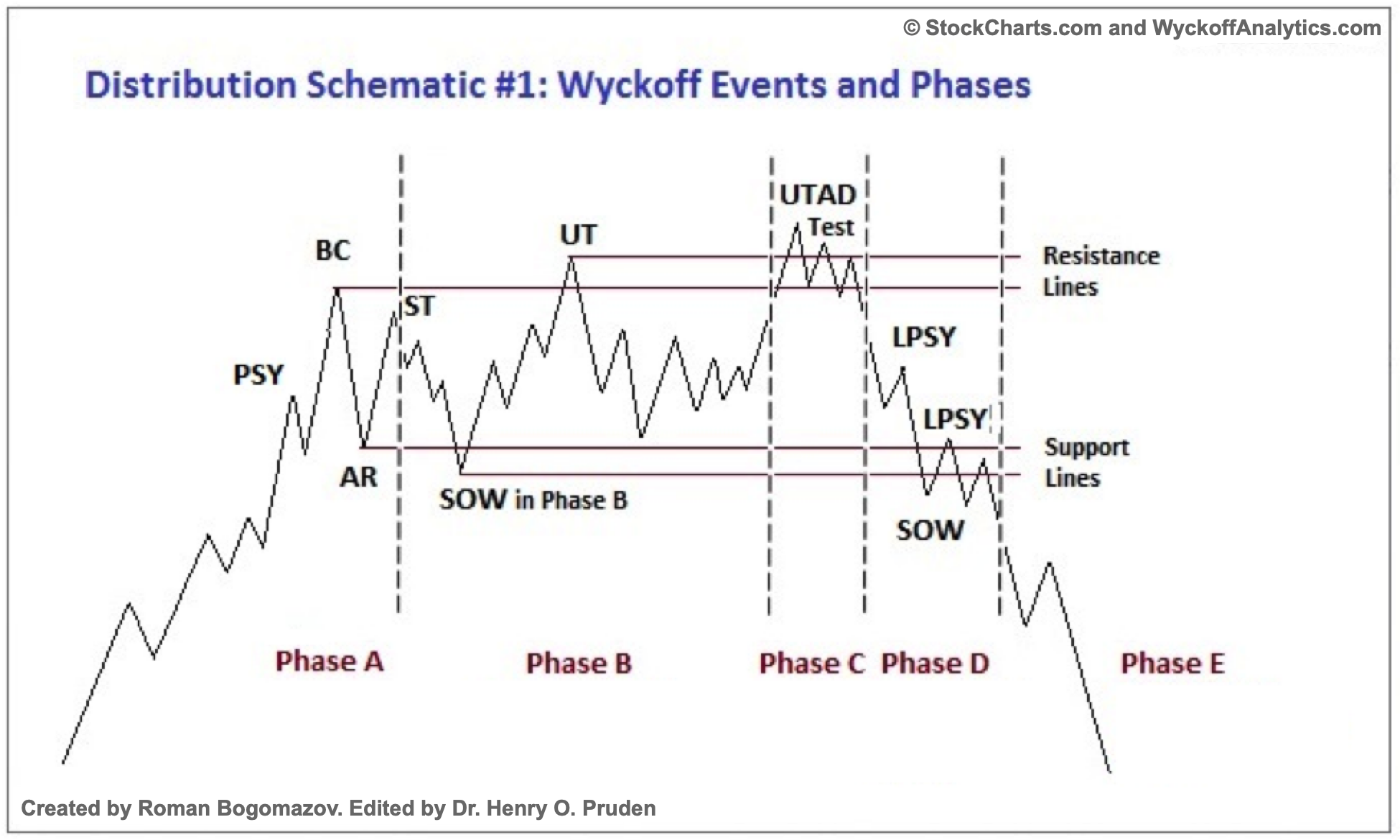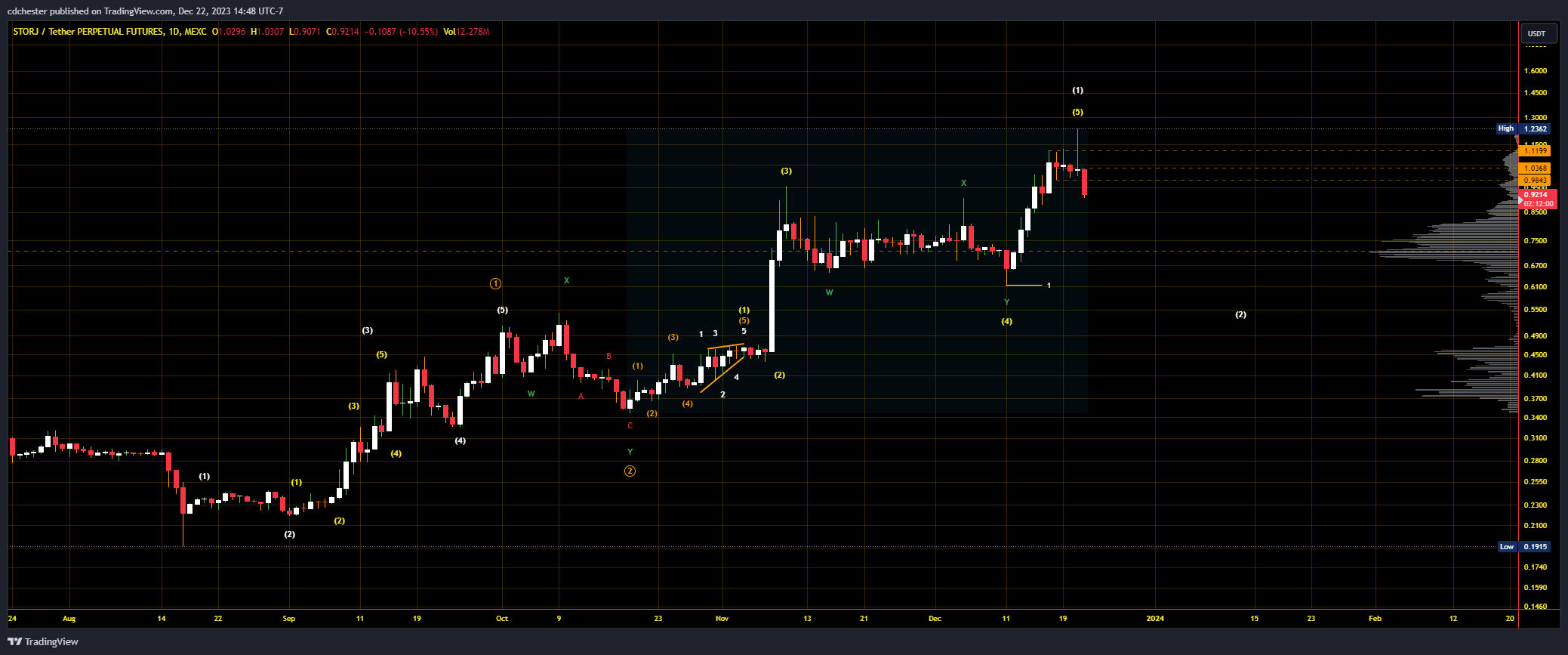Wyckoff Analysis (WA) aims to understand why prices of stocks and other market commodities move due to the dynamics of supply and demand. It is generally applied to any freely traded market where larger or institutional traders are active (commodities, bonds, currencies, etc.). In this article, we will apply WA to the cryptocurrency Storj ($STORJ) to make a prediction for estimated future events.

Storj Price Data from MEXC Futures | Source: STORJUSDT.P on tradingview.com.
Link to the unedited image: https://www.tradingview.com/x/BGsOkzGM
Storj is currently in Phase E of a Wyckoff Distribution Scheme No. 1. StockCharts says this about Phase E in their article about the Wyckoff method:
Phase E shows the development of the downward trend; the stock leaves the TR and the supply is under control. Once TR support is broken at a major SOW, this breakdown is often tested with a rally that fails at or near support. This also represents a high probability opportunity to sell short. Subsequent rallies during the downgrade tend to be weak. Traders who have taken short positions can track their stops as the price drops. After a significant downward movement, a climax may signal the beginning of a redistribution TR or of accumulation.
The trading range for Storj was $1 – $1.12 and has actually fallen below that. From the image below, it appears that a large SOW has occurred, which is more indicative of the occurrence of a distribution. This also coincides with our analyst’s Elliott Wave (EWT) view on Storj. They predict a small rally as Storj continues to decline in Wave 2. Most of the liquidity (according to the relevant volume profile) is between 38.2% and 61.8% LFR, $0.56 and $0.76 respectively. A liquidity cluster is generally expected between these LFRs in EWT, which leads us to believe a Wave 2 correction is underway. Furthermore, the cluster is in the sub-wave 4 price range, an EWT guideline.
Storj Price Data from MEXC Futures | Source: STORJUSDT.P on tradingview.com.
Link to the unedited image: https://www.tradingview.com/x/dD8hv9Aj
Below is the typical schedule for a Wyckoff distribution schedule #1.

Wyckoff Distribution Schematic #1 | Source: StockCharts.com
Word list
All quotes are from the first link in Supplemental Reading.
Provisional delivery (PSY) – “where large holdings begin to sell shares in large quantities after a pronounced upward movement”
Buy climax (B.C) – major operators selling their shares while the public buys them at a premium during a period of huge demand
Automatic response (AR) – “Now that intensive purchases have decreased significantly after the BC and the large supply continues, an AR is taking place”
Secondary test (ST) – when “price revisits the SC area to test the balance between supply and demand at these levels”
Upward force after distribution (UTAD) – “a definitive test of new demand after a breakout above TR resistance”
Test – where larger traders “test the market for supply during a TR”
Sign of weakness (Sow) – “a downward movement towards (or slightly beyond) the lower limit of the TR, usually occurring with greater spread and volume”
Last delivery point (LPSY) – “depletion of demand and the last waves of distribution by major operators before price reduction begins in earnest”
Elliott wave theory (EWT)
“A theory in technical analysis that attributes wave-like price patterns, identified at various scales, to trader psychology and investor sentiment.”
Source: “Elliott Wave Theory: What It Is and How to Use It” by James Chen (2023)
Logarithmic Fibonacci Retracement (LFR) – A measured correction at certain Fibonacci ratios on a semi-log scale.
Logarithmic Fibonacci Extensions (LFE) – A measured rally at certain Fibonacci ratios on a semi-logarithmic scale.
Additional reading
“The Wyckoff Method: A Tutorial” by Bogomazov & Lipsett
“Reaccumulation overview” by Bruce Fraser (2018)
“Jumping the Creek: A Review” by Bruce Fraser (2018)
“Distribution overview” by Bruce Fraser (2018)
“Introduction to point and figure graphs” from Stock Charts
“P&F price targets: horizontal counts” from Stock Charts
“The Wyckoff methodology in depth” by Rubén Villahermosa (2019)
“Wyckoff 2.0: structures, volume profile and order flow” by Rubén Villahermosa (2021)
“Elliott Wave Principle – Key to Market Behavior” by Frost & Prechter (2022)
Disclaimer: The article is for educational purposes only. It does not represent NewsBTC’s views on buying, selling or holding investments and of course investing involves risks. You are advised to conduct your own research before making any investment decisions. Use the information on this website entirely at your own risk.


